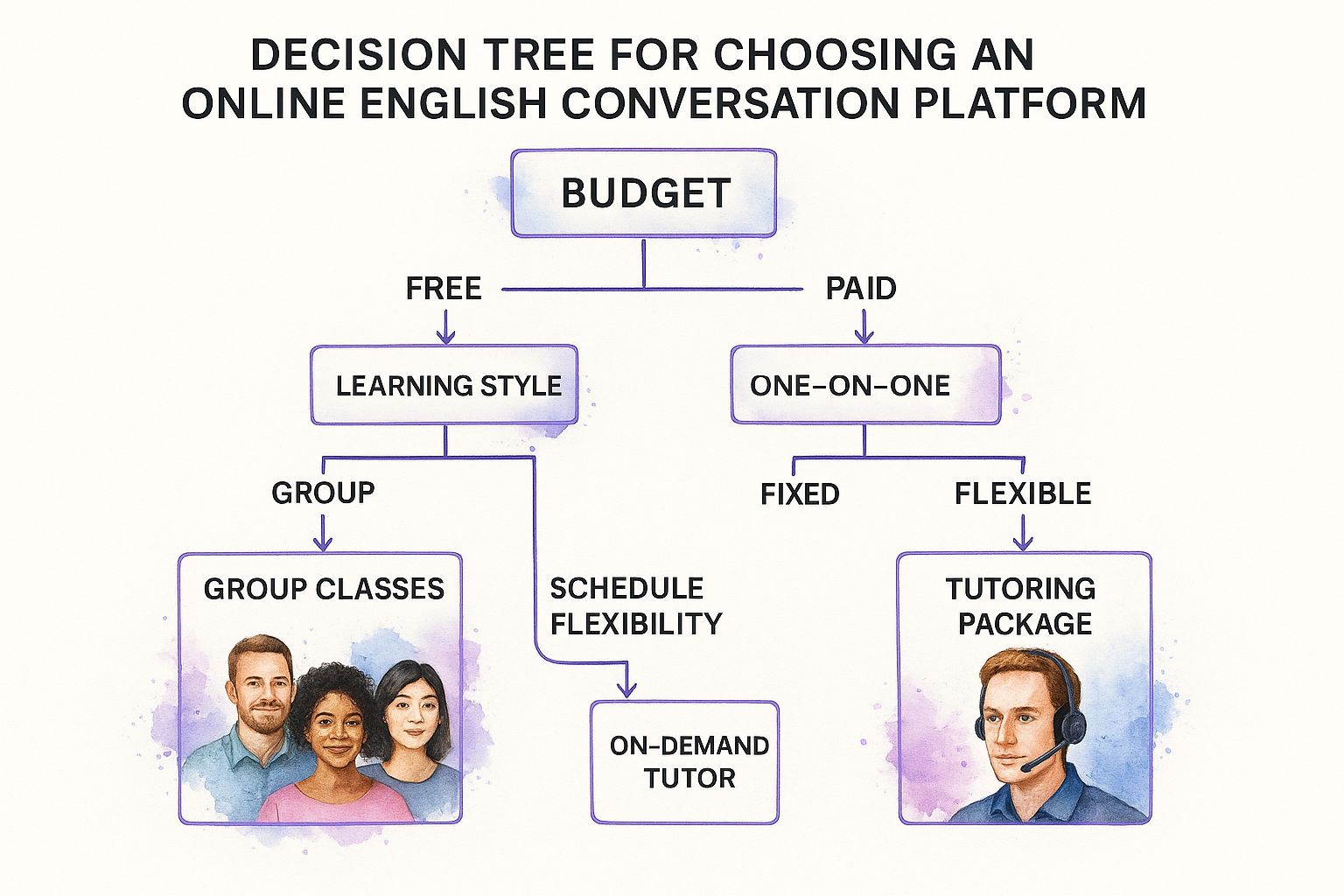Effective English Conversation Practice Online – Improve Fluency
Master your skills with proven English conversation practice online. Get expert tips, tools, and routines to speak confidently and fluently.


You can memorize every grammar rule in the book, but true fluency only comes when you start speaking English with confidence. For a lot of learners, finding ways for effective English conversation practice online is the missing piece that turns passive knowledge into active, real-world communication skills. This guide will show you exactly how to make that happen.
Why Online Practice Unlocks English Fluency

Making the jump from knowing English to actually speaking it can feel like a massive hurdle. It’s easy to get stuck in a cycle of just watching videos or doing grammar drills without ever having a live conversation. This creates a frustrating gap between what you can understand and what you can actually say on the spot.
Often, the biggest roadblocks are mental. The fear of making a mistake, the anxiety of being judged by a native speaker, or just not having anyone to talk with can keep you silent. This is where online platforms completely change the game. They offer a safe, low-pressure space to get over those fears and just start talking.
The Digital Shift in Language Learning
The demand for online English practice has exploded in the last ten years, with digital learning platforms now serving over 500 million users around the world. This trend got a huge push from recent global events, which triggered a 200% increase in online English lessons as everyone moved into virtual spaces. You can see more data on this educational trend over at Kylian.ai.
This huge shift is proof that learners are getting real value from digital tools. Online platforms offer a few key advantages that you just can't get from a traditional classroom:
- Accessibility: You can practice whenever and wherever you want, without having to commute or stick to a strict class schedule.
- Variety: The options are endless. You can talk to an AI tutor for zero-judgment practice, find a language exchange partner, or book a session with a professional tutor.
- Affordability: Many online tools are much easier on the wallet than in-person classes or private lessons.
The goal isn't to be perfect; it's to make progress. Consistent, low-stakes practice is the fastest way to build the conversational muscle you need to speak fluently. Think of every mistake as a stepping stone.
Building Confidence Through Conversation
Confidence isn't something you study for—it's something you build through doing. Every time you have a successful conversation, even a short one, you prove to yourself that you can do it. This chips away at your anxiety and reinforces your skills.
Online tools are perfectly suited for this step-by-step approach. You can start with simple, basic chats and slowly move on to more complex topics as you get more comfortable. If you're just starting out, our guide on English conversation for beginners is a great place to build that initial foundation.
In the end, online platforms have made language learning more accessible to everyone. They've removed the old geographic and financial barriers, putting the power to become a fluent speaker right at your fingertips.
Finding the Right Online Practice Platform for You
With so many options out there, choosing where to start your english conversation practice online can feel a bit like staring at a giant menu in a new restaurant. It’s easy to get overwhelmed.
The secret is to match the platform to what you actually need. Think about your goals, your budget, and how you learn best. What works wonders for one person might be a complete waste of time for another. Understanding the key differences from the get-go will save you a ton of frustration and get you speaking confidently much faster.
Let’s dive into the main types of platforms so you can find your perfect fit.
AI-Powered Tutors: Your 24/7 Practice Partner
AI tutors are a fantastic starting point, especially if you feel a little shy or self-conscious. They offer a completely judgment-free zone to build that initial confidence. The best part? They’re available 24/7, so you can practice whenever you have a spare moment.
The real magic of AI is unlimited repetition. Want to practice ordering a latte ten times in a row until it feels second nature? Go for it. An AI partner will never get bored or impatient, which is incredibly powerful for making new vocabulary and sentence patterns stick in your brain.
Platforms like TalkEasy, for instance, use AI to create conversations that mimic real-life situations. It gives you a safe space to stumble, make mistakes, and try again without any pressure.

As you can see, the interface is clean and focused purely on the conversation. This design helps make the experience feel less intimidating and gets you speaking right away.
Language Exchange Apps: Get Authentic and Make Friends
Language exchange apps pair you with native English speakers who want to learn your language. It's a simple give-and-take: you spend some time talking in English, and then you switch so they can practice with you.
This method is brilliant for picking up the real, everyday language—the slang, the idioms, the way people actually talk. You’re not just learning English; you’re connecting with someone from a different culture. Just be aware that the quality can vary since your partner is a fellow learner, not a trained teacher.
The spontaneity of language exchanges is what makes them so valuable. You’ll be thrown into conversations you didn't prepare for, forcing you to think on your feet—just like in real life.
Online Tutor Marketplaces: Get Polished, Professional Guidance
If you’re looking for structured feedback from a pro, online tutor marketplaces are the way to go. These sites are packed with profiles of vetted English tutors you can book for one-on-one video sessions.
This is your best bet if you have a specific goal in mind, like acing an exam or nailing a business presentation. A good tutor can design lessons just for you and give you expert corrections on everything from grammar to pronunciation. The only real downside is the price tag, as this is usually the most expensive route. If you're watching your budget, our guide on how to practice English conversation for free has some great alternatives.
Community Speaking Clubs: Practice in a Supportive Group
Think of online speaking clubs as the perfect middle ground. These are usually moderated group sessions where a handful of learners get together to discuss a set topic.
The group setting is often incredibly motivating. You’re all in the same boat, which creates a supportive atmosphere. Plus, you get to hear different accents and learn from the questions—and mistakes—of others. It’s a great way to build your confidence for speaking in front of people and sharpens your listening skills at the same time.
To make this all a bit clearer, here's a quick breakdown to help you compare your options.
Choosing Your Online English Practice Tool
A comparison of different platform types to help you find the best fit for your learning style and objectives.
| Platform Type | Best For | Key Features | Example |
|---|---|---|---|
| AI Tutors | Building foundational confidence, high-repetition practice, and 24/7 availability. | Realistic scenarios, instant feedback, no-pressure environment. | TalkEasy |
| Language Exchanges | Cultural immersion, learning informal language, and spontaneous conversation practice. | Partner matching, text/voice chat, peer-to-peer learning. | Tandem |
| Tutor Marketplaces | Specific goals (exams, business), personalized lesson plans, and expert feedback. | Vetted professionals, one-on-one sessions, structured learning. | italki |
| Speaking Clubs | Building confidence in groups, practicing active listening, and peer motivation. | Moderated discussions, diverse topics, supportive community. | Toastmasters |
Ultimately, the right tool is the one that you'll actually use. Think honestly about your personality, schedule, and goals to make the best choice.
A Real-World Scenario: Blending Tools for Success
Let's put this into practice. Meet Maria, a professional who needs to get ready for an international conference in three months. Her English comprehension is solid, but she clams up when she has to speak.
For Maria, a blended approach using different tools would be perfect.
- Months 1-2 (Building Foundational Confidence): Maria starts with an AI tutor for 15-20 minutes every day. She uses this time to rehearse her presentation, practice answering potential questions, and drill key industry terms in a totally stress-free zone.
- Month 2 (Adding Authentic Interaction): Next, she signs up for a language exchange app and schedules two 30-minute calls per week. This gets her accustomed to the flow of a real, unscripted conversation and helps her pick up more natural-sounding phrases.
- Month 3 (Refining with Expert Feedback): In the final stretch, Maria books four one-hour sessions with a professional tutor who specializes in business English. They focus on fine-tuning her delivery, role-playing networking chats, and perfecting her tone and clarity.
By layering these tools, Maria systematically tackles her challenges. The AI helps her overcome her initial fear, the language partner builds her conversational fluidity, and the expert tutor gives her that final polish. She's now ready to walk into that conference and speak with confidence.
How to Build a Consistent Speaking Routine

Knowing what tools to use is a great start, but the real magic happens when you actually show up and use them. Consistency is the engine of language learning, yet it’s often the first thing to go when life gets hectic.
The trick isn’t to find more hours in the day—it’s about building a smart, sustainable habit that fits into the life you already have. Forget vague goals like "I'm going to practice more." That's a recipe for failure because it’s impossible to measure. Instead, let's create a solid framework that makes your english conversation practice online a non-negotiable part of your day.
Set Goals That Actually Work
To build a routine that sticks, you need clarity. Vague ambitions are easy to forget, but specific targets give you something real to work toward. This is where the SMART goal-setting framework comes in handy.
Your goals should be:
- Specific: Don't just say "get better at small talk." Instead, try "I will confidently discuss three of my hobbies for two minutes each."
- Measurable: How do you know you've succeeded? A goal like "discuss a 5-minute news story without using filler words like 'um' or 'ah'" provides a clear benchmark.
- Achievable: Set yourself up for a win. If you're new to speaking, aiming for a 30-minute debate is probably too much. Start with a five-minute conversation and build from there.
- Relevant: Does this goal connect to your "why"? If you need English for work, it makes sense to focus on professional topics.
- Time-bound: Give yourself a deadline. For instance, "I will master my personal introduction by the end of this week."
This simple shift turns a fuzzy wish into an actionable plan. If you're just starting and want some ideas for those first few goals, check out our guide on English speaking practice for beginners.
Master the Art of Habit Stacking
One of the easiest ways to form a new habit is to piggyback it onto something you already do every day. This technique is called habit stacking, and it works because it removes the need for willpower. The new behavior just becomes part of an existing routine.
Think about your daily rituals. Do you always brew coffee in the morning? Do you always walk the dog after work? These are perfect anchor points.
The formula is simple: "After I [Current Habit], I will do [New Habit]." This creates a powerful trigger that, over time, makes your practice automatic.
For example, your new routine might be: "After I pour my morning coffee, I will do a 15-minute conversation practice on TalkEasy." The coffee becomes the cue, making it much harder to forget or skip your session.
Create a Schedule That Fits Your Life
There is no one-size-fits-all schedule. The key is to be brutally honest with yourself about your commitments and your energy levels. Here are a couple of examples to show you how different people can weave practice into their lives.
Sample Schedule A: The Busy Professional
- Monday (15 mins): Morning commute. Listen to a business podcast, then use an AI tutor to verbally summarize the key points.
- Tuesday (20 mins): Lunch break. Practice role-playing a common work scenario, like a client call.
- Wednesday (15 mins): Evening. Wind down with a casual conversation about a personal interest, like a recent movie or travel plan.
- Thursday (20 mins): Lunch break. Review vocabulary from earlier in the week and try to use it in new sentences.
- Friday (30 mins): End of week. Have a longer, more in-depth conversation with a language exchange partner to celebrate the week's progress.
Sample Schedule B: The University Student
- Monday (20 mins): Between classes. Practice discussing a topic from a recent lecture to lock in that academic vocabulary.
- Tuesday (30 mins): Evening. Join an online speaking club to get some group discussion and debate practice.
- Wednesday (20 mins): Afternoon. Use an AI tutor to practice giving a short presentation for an upcoming class project.
- Thursday (15 mins): Morning. Warm up before class with a quick chat about current events.
- Friday (45 mins): Evening. Have a relaxed, longer chat with a language partner about weekend plans, hobbies, and culture.
The most important thing to remember is that short, frequent sessions are far more effective than one long, exhausting cram session per week. Find those little pockets of time in your day and make them count.
Techniques for Mastering Real-World Conversations
https://www.youtube.com/embed/bgfdqVmVjfk
A solid routine is your foundation, but how you practice is what really builds your conversational skills. The whole point of English conversation practice online isn’t just to fill the silence; it’s to prepare you for the real world. You're trying to close the gap between a predictable online chat and a spontaneous, off-the-cuff conversation you'd have at a coffee shop or in a meeting.
To get there, you need to be intentional. Instead of just logging on and hoping for the best, you’ll need specific techniques to prepare, engage, and handle those inevitable bumps in the road. Think of these practice sessions as dress rehearsals for real life—the more you practice the right way, the more natural you'll feel when the curtain goes up.
Set Yourself Up for Success Before You Even Speak
A great conversation rarely happens by accident. Just a few minutes of prep can make a world of difference in your confidence and the quality of your chat. It’s like a musician tuning their instrument before a performance; it just sets the stage for a smoother experience.
This isn't about writing a script. It’s simply about having a few ideas and key phrases ready to go. This simple act takes a huge mental load off your shoulders, so you're not trying to think of topics, vocabulary, and grammar all at once.
One of the best ways to start is to think about topics you're genuinely interested in. When you talk about something you love—a hobby, a movie you just saw, your career—the words just flow better because your enthusiasm does half the work.
- Jot down three topics. Before your session, think of three things you could talk about. Maybe it's a new project at work, a book you're reading, or your weekend plans.
- List five key words. For each topic, identify five vocabulary words you'll probably need. If you're talking about a work project, you might list "deadline," "collaboration," "stakeholder," "milestone," and "feedback."
- Prep one question. Come up with one open-ended question for each topic to ask your partner. This gets them talking and turns a monologue into a real dialogue.
This little bit of prep work is your safety net. It gives you a starting point and helps you avoid those awkward silences where you’re frantically searching for the next thing to say.
It’s Not Just About Talking—Master Active Listening
Speaking is only half the equation. Your ability to listen directly impacts how well you can respond. Active listening isn't just about hearing the words; it's about fully concentrating on the meaning behind them so you can understand, respond, and remember.
When you truly listen, you catch the little things—the tone of voice, the subtle cues, the underlying message. Not only does this make you a much more engaging conversation partner, but it also feeds your brain with more authentic language to learn from.
A conversation is a two-way street. The best speakers are often the best listeners because they use what they hear to ask better questions and make deeper connections.
The easiest way to show you're listening? Ask good follow-up questions. Instead of just nodding along, dig a little deeper. If your partner mentions they had a busy week, don't let that be the end of it. Ask, "Oh really? What kept you so busy?" That one simple question can open up the entire conversation.
How to Handle Those Awkward Pauses Gracefully
Look, everyone stumbles over their words sometimes—even native speakers. It’s a normal part of talking. The secret is not to panic when you can't find the perfect word. Instead of letting the silence hang in the air, have a few "filler phrases" in your back pocket.
These phrases do two things: they buy your brain a few extra seconds to find the word you're looking for, and they make the conversation feel much more natural.
Useful Phrases for When You're Stuck
| Situation | Phrases to Use |
|---|---|
| Forgetting a word | "It's on the tip of my tongue." or "What's the word I'm looking for?" |
| Needing time to think | "That's an interesting question, let me think." or "How can I put this..." |
| Rephrasing an idea | "In other words..." or "What I mean to say is..." |
Using these lets your partner know you're still engaged, which keeps the conversation flowing and takes the pressure off you. This is a game-changer in professional settings, where staying calm and collected is crucial. And in our digital-first world, it's more important than ever. With English appearing on nearly half (49.4%) of all websites, communicating clearly online is a must. You can dive deeper into the web's linguistic landscape on Statista.
Practice for the Moments That Actually Matter
To get the most out of your online practice, you have to connect it to your real life. Role-playing specific scenarios is one of the most effective ways to do this. Got a job interview coming up? A networking event? A debate with friends? Rehearse it.
Let's walk through a common one: making small talk at a professional event.
- The Opening: Don't just say, "How are you?" Start with something based on your shared context. Try, "What did you think of the keynote speaker?" or "What brings you to this event?"
- The Follow-Up: Use the F.O.R.D. method (Family, Occupation, Recreation, Dreams) as a guide to find common ground. Ask questions like, "So, what do you do when you're not working in marketing?"
- The Graceful Exit: Knowing how to end a conversation is a skill in itself. Say something like, "It was great chatting with you. I'm going to grab a drink, but I hope we can connect on LinkedIn."
When you rehearse these exact situations on a platform like TalkEasy, you're building muscle memory. The next time you walk into that networking event, you'll feel prepared and confident because, in a way, you've already been there. This is how you turn abstract practice into a practical, real-world skill.
Keeping Your Momentum: How to Track Progress and Stay Motivated

Starting a consistent routine for your online English conversation practice is a huge first step. But the real challenge? Sticking with it. The secret to long-term motivation isn't about raw willpower; it’s about seeing undeniable proof that your hard work is actually paying off.
When you can clearly see how far you've come, the drive to keep going becomes almost automatic. Let's dig into a few simple but incredibly powerful ways to measure your improvement and keep that fire lit.
Create a Personal "Before and After"
One of the most motivating things you can do is hear your own progress. Our memories are fuzzy, but a recording is undeniable proof of your growth. It creates a concrete benchmark of your skills at a specific point in time.
Here's a simple technique I recommend to everyone:
- Record yourself once a month. Pick a standard topic—introduce yourself, talk about your hobbies, or summarize a news story. Just speak for a couple of minutes.
- Label and file it away. Name the file with the date and forget about it.
- Listen back after three months. Pull up your first recording and your most recent one. Listen to them back-to-back.
You’ll be amazed at the difference. The improvements in your pronunciation, your choice of words, and even your confidence will be much bigger than you realized. This isn't about nitpicking mistakes; it's about appreciating how far you’ve traveled.
Keep a "Win Journal" for Small Victories
Progress isn't always about giant leaps. More often, it's a series of small, consistent wins. A "win journal"—just a simple notebook or a digital doc—is the perfect place to capture them.
Did you finally use a new phrasal verb correctly? Did you get through a whole conversation without reaching for a dictionary? Did you nail the pronunciation of a word that used to trip you up?
Write. It. Down.
Celebrating small wins builds positive momentum. It trains your brain to look for progress instead of fixating on mistakes, which is essential for pushing through the inevitable plateaus in language learning.
On days when you feel stuck or frustrated, flipping through that journal is an instant reminder of how capable you are and how much you've already achieved.
Let Platform Analytics Do the Heavy Lifting
Many modern language platforms, including tools like TalkEasy, have built-in analytics that give you a clear, data-driven look at your development. This goes way beyond just logging your practice hours.
You can often find metrics like:
- Pronunciation Scores: See how your accuracy on specific sounds improves over time.
- Vocabulary Diversity: Track how many new words you're successfully weaving into your speech.
- Fluency Markers: Some tools can even measure your speaking pace and how often you rely on filler words like "um" or "ah."
This kind of data removes the guesswork. You can see your progress in black and white. And the results can be surprisingly fast; one study found that 73% of users could hold a basic conversation after just five hours on some of the leading platforms. A lot of that quick progress comes from the instant, personalized feedback these tools provide. You can find more info on how different platforms support this in this guide to online English courses from Upskillist.
What to Do When You Hit a Plateau
Sooner or later, every single language learner hits a wall. It’s that frustrating period where it feels like you're putting in the work but getting nowhere. It’s completely normal, and the trick is to have a plan to push through it.
When you feel stuck, it’s time to shake things up:
- Switch your topics: If you’re tired of talking about work, spend a week discussing movies, cooking, or a favorite hobby.
- Change the format: If you usually do one-on-one sessions, try joining a group conversation club for a different kind of challenge.
- Zoom in on a micro-skill: Instead of worrying about overall "fluency," dedicate your practice for one week to a single thing, like mastering past-tense verbs.
These plateaus are where the real growth happens. By tracking your progress with recordings, logging your wins, and using platform data, you’ll have hard evidence that even when it feels like you're standing still, you’re actually still moving forward.
Your Questions About Practicing English Online, Answered
As you get started with online English conversation practice, you’re bound to have some questions. It's totally normal. Getting those questions answered is what helps you move forward with confidence and make every minute of your practice time count.
Let's dive into some of the most common things learners ask. My goal here is to give you some straightforward advice that builds on what we've already covered and helps you clear any final hurdles.
How Long Until I'm Fluent with Online Practice?
Ah, the big question! The truth is, "fluency" is more of a journey than a finish line, and everyone's path looks a little different. Your starting point, how often you practice, and even your native language all come into play. But the one thing you have total control over is consistency—and that’s the most powerful factor of all.
From what I’ve seen, most learners who commit to just 20-30 minutes of daily practice start to feel a real, noticeable boost in their confidence and conversational skills within three to six months.
What really matters is the quality and consistency of your practice, not just the number of hours you put in. If you focus on small, daily improvements and really engage with the material, you’ll see progress much faster than you might expect.
Instead of getting fixated on that big, distant goal of "fluency," try aiming for smaller, tangible wins. For example, make it a goal to hold a five-minute conversation about a new topic each week. That's how you build momentum and watch your skills grow step-by-step.
Are AI Conversation Partners as Good as Human Tutors?
This is a great question, and the answer isn't a simple "yes" or "no." Think of them as different tools for different jobs. It’s not about which one is better, but which one is the right fit for what you need to accomplish at that moment.
AI partners really shine when it comes to:
- High-Volume Practice: You can have dozens of conversations without worrying about anyone else's schedule. It’s perfect for building that conversational muscle memory.
- A No-Pressure Environment: The freedom to make mistakes without feeling judged is incredibly powerful, especially when you're just starting out.
- Cost-Effectiveness: Let's be honest, AI tools are far more affordable, which makes daily practice a realistic option for almost everyone.
Human tutors are irreplaceable for:
- Nuanced Feedback: A person can pick up on subtle cultural context, the right tone of voice, and the complex back-and-forth that AI might not fully grasp yet.
- Personalized Strategy: A human can help you prep for something specific, like a job interview, with targeted coaching and real-world insights.
- Building Real-World Rapport: There's no substitute for practicing with a real person to get comfortable with the natural, sometimes unpredictable, rhythm of human interaction.
For the best results? Use both. Lean on an AI tool like TalkEasy for your daily drills and confidence-building. Then, book sessions with a human tutor when you need that expert, targeted feedback to level up.
What if I'm Too Shy to Speak with a Real Person?
If this is you, you are definitely not alone. It's probably the most common fear learners face. That anxiety about being judged or messing up in front of a native speaker can feel like a huge wall. This is exactly where modern online tools can be a total game-changer.
Start your practice where the stakes are zero. An AI tutor gives you a completely private, judgment-free space to talk. You can say the same sentence ten times in a row to get it right, and the AI will never get bored or impatient. This is how you build a solid foundation of vocabulary and sentence structures without the pressure.
Once you start feeling more confident with an AI, take the next small step. Maybe try a low-stakes text chat on a language exchange app. From there, you could move on to sending a short voice message, and then eventually, a live call with another learner. It’s all about taking small, manageable steps that gradually build your comfort level.
How Do I Find Good Topics to Talk About?
Running out of things to say is a common worry, but it's easily solved with a bit of prep. The best topics, hands down, are the things you’re genuinely passionate about. When you talk about your hobbies, your job, a movie you just saw, or your travel plans, the words tend to flow more easily because your enthusiasm is doing half the work for you.
The world around you is another fantastic source of conversation starters. Grab a recent news article, a podcast episode you listened to, or even a YouTube video you enjoyed. This gives you a clear subject to discuss and some built-in vocabulary to use.
If you ever feel stuck trying to structure your thoughts, try the "PREP" method. It's a simple but incredibly effective technique:
- Point: State your main idea clearly.
- Reason: Explain why you feel that way.
- Example: Give a specific example to back it up.
- Point: Restate your main point to wrap things up.
This little framework helps you organize your ideas on the fly, so you can give more thoughtful and detailed answers to pretty much any question that comes your way.
Ready to turn all this knowledge into action and start speaking with real confidence? TalkEasy provides that judgment-free space you need to practice real-world conversations, anytime you want. Start your journey to fluency today by visiting https://www.talk-easy.com.